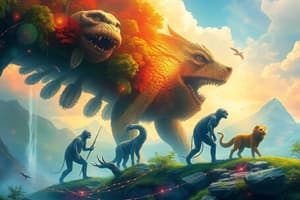Podcast
Questions and Answers
Which of the following is NOT a key adaptation for life on land?
Which of the following is NOT a key adaptation for life on land?
- Sporopollenin
- Photosynthesis (correct)
- Vascular tissue
- Multicellular gametangia
Which of the following is a challenge that plants faced when transitioning from water to land?
Which of the following is a challenge that plants faced when transitioning from water to land?
- Fewer herbivores
- Increased availability of sunlight
- Abundant mineral nutrients
- Gravity (correct)
Which of the following is a secondary compound that acts as a defense mechanism for plants, often producing a bitter taste?
Which of the following is a secondary compound that acts as a defense mechanism for plants, often producing a bitter taste?
- Terpenes
- Alkaloids
- Tannins
- All of the above (correct)
In the context of plant life cycles, what is the dominant generation in most plants today?
In the context of plant life cycles, what is the dominant generation in most plants today?
Which of the following accurately describes the role of stomata in plants?
Which of the following accurately describes the role of stomata in plants?
Which of the following is NOT a characteristic of gymnosperms?
Which of the following is NOT a characteristic of gymnosperms?
Which of the following protists is responsible for causing malaria in humans?
Which of the following protists is responsible for causing malaria in humans?
Which of the following is a true statement about both plants and fungi?
Which of the following is a true statement about both plants and fungi?
What is the smallest unit that can evolve?
What is the smallest unit that can evolve?
Which of the following concepts is NOT associated with Lamarck's ideas about evolution?
Which of the following concepts is NOT associated with Lamarck's ideas about evolution?
What is the primary difference between Darwin's theory of evolution and Lamarck's theory?
What is the primary difference between Darwin's theory of evolution and Lamarck's theory?
Which of the following is NOT a piece of evidence supporting evolution?
Which of the following is NOT a piece of evidence supporting evolution?
What is the relationship between biodiversity and human health?
What is the relationship between biodiversity and human health?
What is the primary mechanism driving evolution?
What is the primary mechanism driving evolution?
Which of the following best describes the concept of 'fitness' in evolutionary terms?
Which of the following best describes the concept of 'fitness' in evolutionary terms?
What is the significance of understanding the age of the Earth for the study of evolution?
What is the significance of understanding the age of the Earth for the study of evolution?
What is the main mechanism by which evolution occurs?
What is the main mechanism by which evolution occurs?
Which of the following is NOT a direct piece of evidence used to support the theory of evolution?
Which of the following is NOT a direct piece of evidence used to support the theory of evolution?
What is the correct order of taxonomic groups, from most inclusive to least inclusive?
What is the correct order of taxonomic groups, from most inclusive to least inclusive?
Which of these is NOT a characteristic of prokaryotes?
Which of these is NOT a characteristic of prokaryotes?
What is the primary function of peptidoglycan in bacteria?
What is the primary function of peptidoglycan in bacteria?
Which of the following is a characteristic that distinguishes archaea from bacteria?
Which of the following is a characteristic that distinguishes archaea from bacteria?
Which of these statements accurately describes the relationship between prokaryotes and eukaryotes?
Which of these statements accurately describes the relationship between prokaryotes and eukaryotes?
Which of the following is NOT a valid reason why prokaryotes are so successful?
Which of the following is NOT a valid reason why prokaryotes are so successful?
What is the primary difference between exotoxins and endotoxins?
What is the primary difference between exotoxins and endotoxins?
What is the significance of serial endosymbiosis in the evolution of eukaryotic cells?
What is the significance of serial endosymbiosis in the evolution of eukaryotic cells?
Which of the following is NOT a characteristic of protists?
Which of the following is NOT a characteristic of protists?
Which of the following is an example of a homologous structure?
Which of the following is an example of a homologous structure?
What is the defining characteristic of an endemic species?
What is the defining characteristic of an endemic species?
Which of these is an example of convergent evolution?
Which of these is an example of convergent evolution?
What is the relationship between natural selection and mutations?
What is the relationship between natural selection and mutations?
What is the Hardy-Weinberg equation used to calculate?
What is the Hardy-Weinberg equation used to calculate?
Flashcards
Biodiversity
Biodiversity
Variation of life forms at all levels, linked to ecosystems and health.
Unity in biodiversity
Unity in biodiversity
Shared characteristics among life forms indicating common ancestry.
Evolution
Evolution
Change in allele frequencies in a population over generations, not individuals.
Natural selection
Natural selection
Signup and view all the flashcards
Fossil record
Fossil record
Signup and view all the flashcards
Catastrophism
Catastrophism
Signup and view all the flashcards
Uniformitarianism
Uniformitarianism
Signup and view all the flashcards
Fitness
Fitness
Signup and view all the flashcards
Diatoms
Diatoms
Signup and view all the flashcards
Brown Algae
Brown Algae
Signup and view all the flashcards
Giardia
Giardia
Signup and view all the flashcards
Sporopollenin
Sporopollenin
Signup and view all the flashcards
Apical Meristems
Apical Meristems
Signup and view all the flashcards
Vascular Tissue
Vascular Tissue
Signup and view all the flashcards
Alkaloids
Alkaloids
Signup and view all the flashcards
Gymnosperms
Gymnosperms
Signup and view all the flashcards
Adaptations
Adaptations
Signup and view all the flashcards
Microevolution
Microevolution
Signup and view all the flashcards
Artificial selection
Artificial selection
Signup and view all the flashcards
Homologous structures
Homologous structures
Signup and view all the flashcards
Analogous structures
Analogous structures
Signup and view all the flashcards
Vestigial structures
Vestigial structures
Signup and view all the flashcards
Convergent evolution
Convergent evolution
Signup and view all the flashcards
Endemic species
Endemic species
Signup and view all the flashcards
Phylogenetic tree
Phylogenetic tree
Signup and view all the flashcards
Prokaryotes
Prokaryotes
Signup and view all the flashcards
Eukaryotes
Eukaryotes
Signup and view all the flashcards
Endosymbiosis
Endosymbiosis
Signup and view all the flashcards
Abiogenesis
Abiogenesis
Signup and view all the flashcards
Microbiome
Microbiome
Signup and view all the flashcards
Study Notes
Biodiversity and the Unity and Diversity of Life
- Biodiversity encompasses the variation of life at all levels, from genes to ecosystems.
- It's crucial due to its connection to human health.
- Biodiversity shows both the unity and diversity of life.
- Unity arises from shared ancestry; diversity reflects environmental influences.
Evolution: A Pattern and Process
- Evolution occurs in populations, not individuals, and isn't goal-directed.
- It represents a change in allele frequencies over generations.
- Heritable traits aid descendants in natural selection.
- Populations are the smallest units capable of evolving.
Supporting Evidence for Evolution
- Fossil record, homologies, direct observations, and molecular DNA all support evolution.
- Evolution is both a pattern and a process.
- Natural selection drives the patterns observed over time.
- Species were once believed to be immutable.
- Early understandings of species' immutability were influenced by religious beliefs on the Creator's plan.
- Natural theology, the idea that natural structures reflect a divine plan emerged from Linnaeus's work
- Georges Cuvier, a founder of paleontology, observed similar organisms across strata, suggesting catastrophic events, not gradual change.
- Catastrophism hypothesizes that existing species are created successively, not evolving
- James Hutton and Charles Lyell proposed the concept of uniformitarianism to understand that the same processes that operate now have operated throughout time
- The Earth is 4.6 billion years old, showing a long span of time for evolution to occur.
- Malthus's economic theories showed that populations grow exponentially but food supply does not, leading to competition among organisms
- Lamarck incorrectly proposed that acquired traits during an organism's lifetime can be passed to offspring. He also proposed that organisms have an inherent drive towards complexity.
- Individuals match their environment through inherited adaptations.
- Fitness measures an organism's contribution to the gene pool of the next generation.
- Adaptations are traits that enhance an organism's fitness in its environment.
Natural Selection
- Individuals in populations show variations in traits.
- Traits are inherited from parents to offspring.
- Species can produce more offspring than the environment can support.
- Limited resources lead to competition and differential survival.
- Individuals with traits that enhance survival in a specific environment tend to leave more offspring.
- Natural selection does not lead to a specific goal.
- Artificial selection is different from natural selection because it is controlled by human choice and not environmental pressures.
- Individuals do not evolve, natural selection acts on heritable traits.
Evidence and Mechanisms of Evolution (continued)
- Vestigial structures are remnants of structures that have lost their original function.
- Convergent evolution shows similar characteristics arising independently in different lineages (analogous structures).
- Homologous characteristics evolved from a common ancestor.
- Phylogenetic trees show evolutionary relationships with a root (common ancestor), branches, nodes (divergence points), and tips (taxa, species).
- Endemic species are found only in one geographic location.
- Microevolution involves genetic changes within a population.
Variation
- Mutations are random changes in DNA sequence and are the ultimate source of genetic variation (and evolution).
- Mutations aren't always beneficial.
- Recessive alleles may be masked in heterozygotes.
- Mutations must occur in the germline to be heritable.
Prokaryotes
- The domains are Eukarya (eukaryotes), Bacteria, and Archaea (prokaryotes).
- Prokaryotes are widespread and adaptable to diverse environments.
- Prokaryotes exhibit various shapes (spheres, rods, spirals).
- Prokaryotes reproduce asexually by binary fission.
- Many prokaryotes use different metabolic strategies like photoautotrophy, chemoautotrophy, photoheterotrophy, and chemoheterotrophy.
- Bacterial cell walls contain peptidoglycan.
- Prokaryotes play crucial roles in decomposition and nutrient cycling.
- Some prokaryotes cause disease through exotoxins or endotoxins.
Eukaryotes
- Eukaryotes have a nucleus and membrane-bound organelles.
- Mitochondria and plastids may have originated from prokaryotic endosymbionts.
- Endosymbiotic theory proposes that eukaryotic organelles arose from engulfed prokaryotes.
Protists
- Protists are a diverse group of mostly unicellular eukaryotic organisms.
- Protists are incredibly important to global ecosystems: they are primary producers.
- Protists may be photosynthetic, heterotrophic, or mixotrophic.
- Protists have several roles in the environment and as diseases.
- Examples: diatoms, brown algae, Giardia, Plasmodium (malaria), Phytophthora (Sudden Oak Death).
Plants
- Plants adapted to terrestrial life through various evolutionary innovations, like sporopollenin, embryos, vascular tissue, seeds, and flowers.
- Challenges of adapting to land included gravity, lack of water, and environmental fluctuations.
- Plants evolved adaptations like spores, multicellular embryos, sporangia, gametangia, and apical meristems.
- Stomata allow plants to exchange gases with the atmosphere.
- Plants produce secondary metabolites for defense.
- Vascular tissue transports water and nutrients, providing structural support.
- Important plant secondary compounds: Alkaloids, Terpenes, Tannins, and Flavonoids.
- Seeds allow for dormancy and dispersal.
- Gymnosperms and angiosperms are two major groups of seed plants.
- Angiosperms have flowers.
Plant Classification
- Plants have distinct evolutionary groups, categorized based on characteristics like reproductive structures.
- Sporophyte (diploid) and gametophyte (haploid) generations are emphasized.
Studying That Suits You
Use AI to generate personalized quizzes and flashcards to suit your learning preferences.




